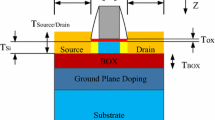Abstract
The study presents an investigation into the proton-induced current transient in a silicon-germanium heterojunction bipolar transistor (SiGe HBT). The temporal information of the proton-induced current transients is first measured and then compared with results from heavy ion microbeam experiment. Additionally, a model for proton-induced charge collection based on Geant4 Monte Carlo simulation tools is constructed by using the information from heavy ion experiment and 3D TCAD simulation. The results obtained by the validated model exhibit good consistency with the proton experiment.
Similar content being viewed by others
References
Cressler J D. SiGe HBT technology: A new contender for Si-based RF and microwave circuit applications. IEEE Trans Microwave Theor Techn, 1998, 46: 572–589
Sutton A K, Haugerud B M, Yuan Lu B M, et al. Proton tolerance of fourth-generation 350 GHz UHV/CVD SiGe HBTs. IEEE Trans Nucl Sci, 2004, 51: 3736–3742
Cressler J D. Radiation effects in SiGe technology. IEEE Trans Nucl Sci, 2013, 60: 1992–2014
Cressler J D, Hamilton M C, Mullinax G S, et al. The effects of proton irradiation on the lateral and vertical scaling of UHV/CVD SiGe HBT BiCMOS technology. IEEE Trans Nucl Sci, 2000, 47: 2515–2520
Cressler J D. On the Potential of SiGe HBTs for extreme environment electronics. Proc IEEE, 2005, 93: 1559–1582
Krithivasan R, Yuan Lu R, Cressler J D, et al. Half-terahertz operation of SiGe HBTs. IEEE Electron Device Lett, 2006, 27: 567–569
Marshall P W, Carts M A, Campbell A, et al. Single event effects in circuit-hardened SiGe HBT logic at Gigabit per second data rates. IEEE Trans Nucl Sci, 2001, 47: 2669–2674
Montes E J, Reed R A, Pellish J A, et al. Single event upset mechanisms for low-energy-deposition events in SiGe HBTs. IEEE Trans Nucl Sci, 2008, 55: 1581–1586
Vizkelethy G, Phillips S D, Najafizadeh L, et al. Nuclear microbeam studies of silicon-germanium heterojunction bipolar transistors (HBTs). Nucl Instruments Methods Phys Res Sect B-Beam Interactions Mater Atoms, 2010, 268: 2092–2098
Pellish J A, Reed R A, Sutton A K, et al. A generalized SiGe HBT single-Event effects model for on-orbit event rate calculations. IEEE Trans Nucl Sci, 2007, 54: 2322–2329
Pellish J A, Reed R A, McMorrow D, et al. Heavy ion microbeam- and broadbeam-induced transients in SiGe HBTs. IEEE Trans Nucl Sci, 2009, 56: 3078–3084
Varadharajaperumal M, Niu G, Krithivasan R, et al. 3-D simulation of heavy-ion induced charge collection in SiGe HBTs. IEEE Trans Nucl Sci, 2004, 50: 2191–2198
Marshall P, Carts M, Campbell A, et al. A comparative study of heavy-ion and proton-induced bit-error sensitivity and complex burst-error modes in commercially available high-speed SiGe BiCMOS. IEEE Trans Nucl Sci, 2004, 51: 3457–3463
Sutton A K, Moen K, Cressler J D, et al. Proton-induced SEU in SiGe digital logic at cryogenic temperatures. Solid State Electron, 2008, 52: 1652–1659
Zhang J, Guo Q, Guo H, et al. Impact of bias conditions on total ionizing dose effects of in SiGe HBT. IEEE Trans Nucl Sci, 2016, 63: 1251–1258
Liu M H, Lu W, Ma W Y, et al. Total ionizing dose effects of domestic SiGe HBTs under different dose rates. Chin Phys C, 2016, 40: 036003
Zhang J, Guo H, Zhang F, et al. Heavy ion micro-beam study of single-event transient (SET) in SiGe heterjunction bipolar transistor. Sci China Inf Sci, 2017, 60: 120404
Reed R A, Marshall P W, Pickel J C, et al. Heavy-ion broad-beam and microprobe studies of single-event upsets in 0.20-μm SiGe hetero-junction bipolar transistors and circuits. IEEE Trans Nucl Sci, 2004, 50: 2184–2190
Li P, He C H, Guo G, et al. Heavy ion and laser microbeam induced current transients in SiGe heterojunction bipolar transistor. Chin Phys Lett, 2017, 34: 108501
Zhang J, He C, Guo H, et al. 3-D simulation study of single event effects of SiGe heterojunction bipolar transistor in extreme environment. MicroElectron Reliability, 2015, 55: 1180–1186
Wei J, He C, Li P, et al. Simulation of substrate contact effects on heavy ion-induced current transient in SiGe HBT. MicroElectron Reliability, 2019, 95: 28–35
Varadharajaperumal M, Niu G, Wei X, et al. 3-D simulation of SEU hardening of SiGe HBTs using shared dummy collector. IEEE Trans Nucl Sci, 2007, 54: 2330–2337
Wei J N, He C H, Li P, et al. Research on SEE mitigation techniques using back junction and p+ buffer layer in domestic non-DTI SiGe HBTs by TCAD. Chin Phys B, 2019, 28: 068503
Messenger G C, Ash M S. Single Event Phenomena. Boston: Springer, 1997
Warren K M, Sierawski B D, Weller R A, et al. Predicting thermal neutron-induced soft errors in static memories using TCAD and physics-based Monte Carlo simulation tools. IEEE Electron Device Lett, 2007, 28: 180–182
Warren K M, Weller R A, Sierawski B D, et al. Application of RADSAFE to model the single event upset response of a 0.25 μm CMOS SRAM. IEEE Trans Nucl Sci, 2007, 54: 898–903
Pellish J A, Reed R A, Schrimpf R D, et al. Substrate engineering concepts to mitigate charge collection in deep trench isolation technologies. IEEE Trans Nucl Sci, 2006, 53: 3298–3305
Author information
Authors and Affiliations
Corresponding author
Additional information
This work was supported by the National Natural Science Foundation of China (Grant Nos. 11775167, 61574171 and 11575138). The authors would like to thank the staffs of CIAE for the help during proton irradiation experiment.
Rights and permissions
About this article
Cite this article
Wei, J., Li, Y., Yang, W. et al. Proton-induced current transient in SiGe HBT and charge collection model based on Monte Carlo simulation. Sci. China Technol. Sci. 63, 851–858 (2020). https://doi.org/10.1007/s11431-019-1474-x
Received:
Accepted:
Published:
Issue Date:
DOI: https://doi.org/10.1007/s11431-019-1474-x




